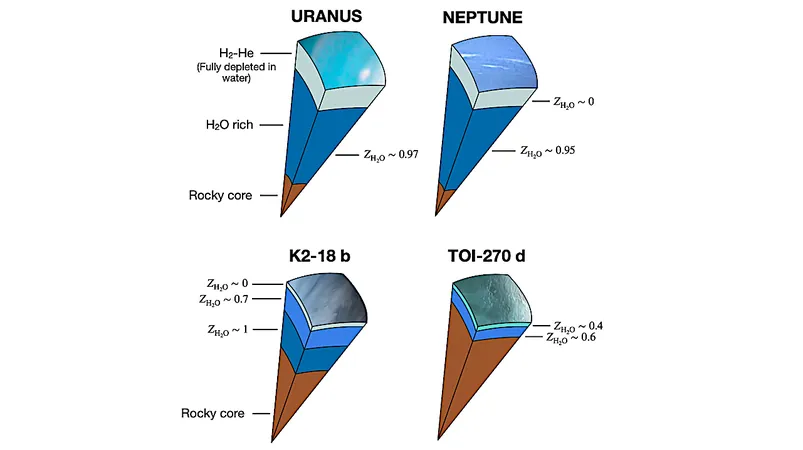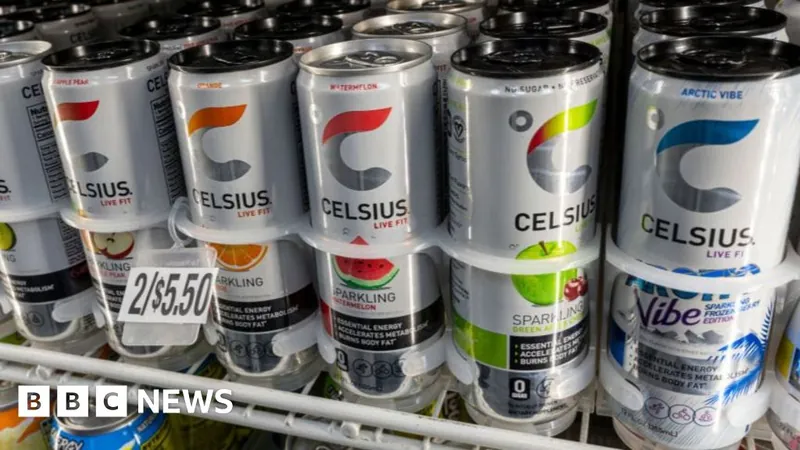
Revealing Secrets: Water Demixing in Uranus, Neptune, and Exoplanet K2-18 b
2025-07-13
Author: Benjamin
Unveiling the Mysteries of Ice Giants
The hidden structures of our Solar System’s ice giants, Uranus and Neptune, are shrouded in mystery. As astronomers dive deeper into the cosmos, sub-Neptunes have emerged as the most frequently encountered exoplanets, making the understanding of their internal dynamics all the more crucial.
The Science Behind Phase Separation
Recent research has highlighted a fascinating process known as phase separation between hydrogen and water, particularly in cold, water-rich planets like our neighboring giants and certain exoplanets. By examining Uranus, Neptune, and noteworthy exoplanets such as K2-18 b and TOI-270 d, scientists are piecing together the effects of this phenomenon on planetary evolution and internal structure.
Groundbreaking Modeling Approaches
Utilizing cutting-edge planetary evolution models combined with advanced ab initio calculations, researchers are now able to explore the hydrogen-water phase diagram more comprehensively. This innovative approach considers temperature variations that could influence water's unique behaviors under extreme conditions.
Finding Potential Demixing in Uranus and Neptune
The findings are staggering: demixing could result in a significant depletion of water in the outer layers of Uranus and Neptune! Temperature shifts as high as 1,100 K could create a water-sparse region, potentially making up 16% of a planet’s total mass and inflating its radius by nearly 20%.
K2-18 b: A Closer Look at Water Features
For the intriguing exoplanet K2-18 b, models suggest that hydrogen-water demixing is currently happening. This could shed light on the mysterious absence of water features in its JWST spectrum, with a crucial 500 K temperature offset resulting in water depletion in its atmosphere.
Insights on TOI-270 d
TOI-270 d may also show signs of hydrogen-water demixing. By applying similar temperature adjustments as observed in K2-18 b, researchers suggest a partial reduction of water in TOI-270 d's atmosphere aligns with JWST findings of water presence.
Implications for Future Discoveries
The implications of hydrogen-water immiscibility extend far beyond our Solar System. Understanding how these internal processes shape the giants of our neighborhood and the cold or temperate exoplanets is vital for accurately interpreting atmospheric observations from the James Webb Space Telescope (JWST) and upcoming missions like ARIEL.
The Pioneers Behind the Research
This groundbreaking study is led by a team of researchers, including Saburo Howard, Ravit Helled, Armin Bergermann, and Ronald Redmer, who together are unlocking the enigmatic interiors of the universe's most intriguing planets.









 Brasil (PT)
Brasil (PT)
 Canada (EN)
Canada (EN)
 Chile (ES)
Chile (ES)
 Česko (CS)
Česko (CS)
 대한민국 (KO)
대한민국 (KO)
 España (ES)
España (ES)
 France (FR)
France (FR)
 Hong Kong (EN)
Hong Kong (EN)
 Italia (IT)
Italia (IT)
 日本 (JA)
日本 (JA)
 Magyarország (HU)
Magyarország (HU)
 Norge (NO)
Norge (NO)
 Polska (PL)
Polska (PL)
 Schweiz (DE)
Schweiz (DE)
 Singapore (EN)
Singapore (EN)
 Sverige (SV)
Sverige (SV)
 Suomi (FI)
Suomi (FI)
 Türkiye (TR)
Türkiye (TR)
 الإمارات العربية المتحدة (AR)
الإمارات العربية المتحدة (AR)